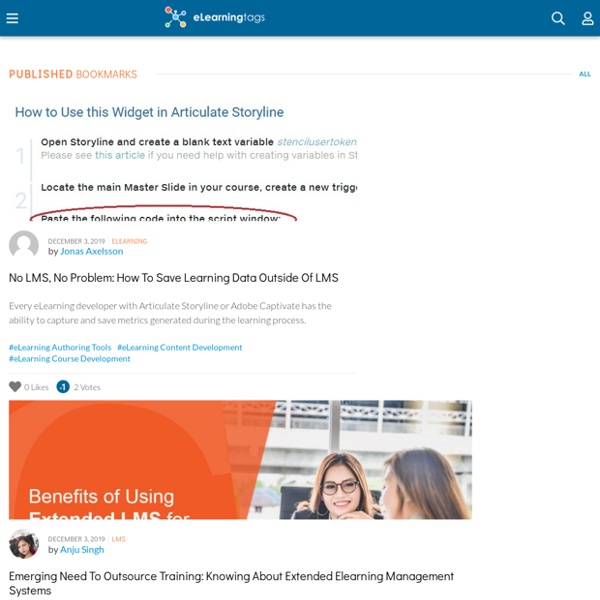



Type Fu - touch typing trainer, tutor and test All your favorite things, side-by-side. What Is Agile Learning Design? If you’re in the learning design business, then you’ve probably come across the term “Agile” recently. You also might have heard terms that sound like a different language, like Kanban or Scrum. All this new terminology can get confusing, so that’s why we’re going to try and make sense of it. Agile is a fresh approach to learning design that takes the ADDIE model to a new level. It All Started With a Problem Agile started as a software development process. The problem is that this method is extremely impractical for software development. The Manifesto for Agile Software Development By the mid-90s, software developers had had enough, and they came up with their own ways of doing things. It defined the Agile development process as an iterative method based on collaboration. So What Does This Mean for Me? I’m sure by now you are eager to find out what this has to do with us, the learning designers. But let’s make this more real. What’s something new about Agile that you like?
- 30 Online Multimedia Resources for PBL and Flipped Classrooms by Michael Gorman 1 Comment May 28, 2012 By: Michael Gorman May 28 Written by: 5/28/2012 12:30 AM ShareThis Welcome to the another in a series of PBL Mania Posts here at Tech & Learning. In this PBL Mania Post I explore Online Multimedia Resources. WGBH Teacher Domain - Teachers' Domain is a free digital media service for educational use from public broadcasting and its partners. PBS Teachers – Launched within the last year, PBS Teachers is an awesome place for all kinds of educational multimedia. The Khan Academy – At Khan, students and teachers are encouraged to “Watch… Practice… Learn almost anything for free”. YouTube – Let’s not forget YouTube and its amazing searchable collection. Thinkfinity – This site is worth an entire write-up in itself and will provide a wealth of activities for PBL products. NeoK12 - Take a look and you will find a vast collection of resources and Web 2.o tools that might fit into any lesson. PicsForLearning - Not everything has to be video.
7 Ways to Make Your Mandatory Training More Exciting! Annual mandatory training is common in many organizations, but does not always scream excitement to employees. It’s that dreaded time of the year employees hope to get the checkmark for and revisit 12 months later. Hearing that training is a must may even cause stress and anxiety. You can incorporate many ideas and concepts into your mandatory training to make it a little less stressful. Create a Dynamic Framework Create a framework that allows content to easily evolve and develop over time rather than repeating the same content each year. These are just a few ways you can make your annual training less stressful and more exciting.
Learn Touch Typing Free - TypingClub Mural.ly Rich Internet Applications from the Center for Language Education And Research (CLEAR) at Michigan State University About Rich Internet Applications (RIA) The goal of the Rich Internet Applications project is to create tools that are informed by language acquisition research, and engage language learners in active learning. Using our Rich Internet Applications toolset, incorporating speaking and listening into your language class is easier and more flexible than ever! The tools can be used in many different ways: for in-class activities, student projects, homework, or assessment. Because they are tools, not completed materials, they will work with your textbook, language, and level. The programs are free to use. The Rich Internet Applications tools run in your web browser.
Therapy: An Introduction Internet search engines offer this as one of the top results when you search for Gestalt Therapy. For some reason, they rank it even higher than the home page for the site where it appears, The Gestalt Therapy Page. For a wealth of more materials relating to the theory and practice of Gestalt therapy, visit our home page for a complete list of the contents. Gestalt Therapy: An Introduction by Gary Yontef, Ph.D. This introductory chapter appears in Awareness, Dialogue, and Process published by The Gestalt Journal Press and was copyright in 1993 by Gary Yontef, Ph.D. Order a copy of Awareness, Dialogue and Process today at special discount prices from: Amazon.com Amazon.uk.com The book is also available in the following languages. GermanGestalttherapie: Awareness - Dialogue - Prozess ISBN 3-9804784-0-8 EHP (Edition Humanistische Psychologie) EM 58 Tel: 0221-5304411 Fax: 0221-5302062 Postfach 32 01 73, 50795 Köln, Germany Commentary This paper, coauthored with James S. Overview Basic Concepts